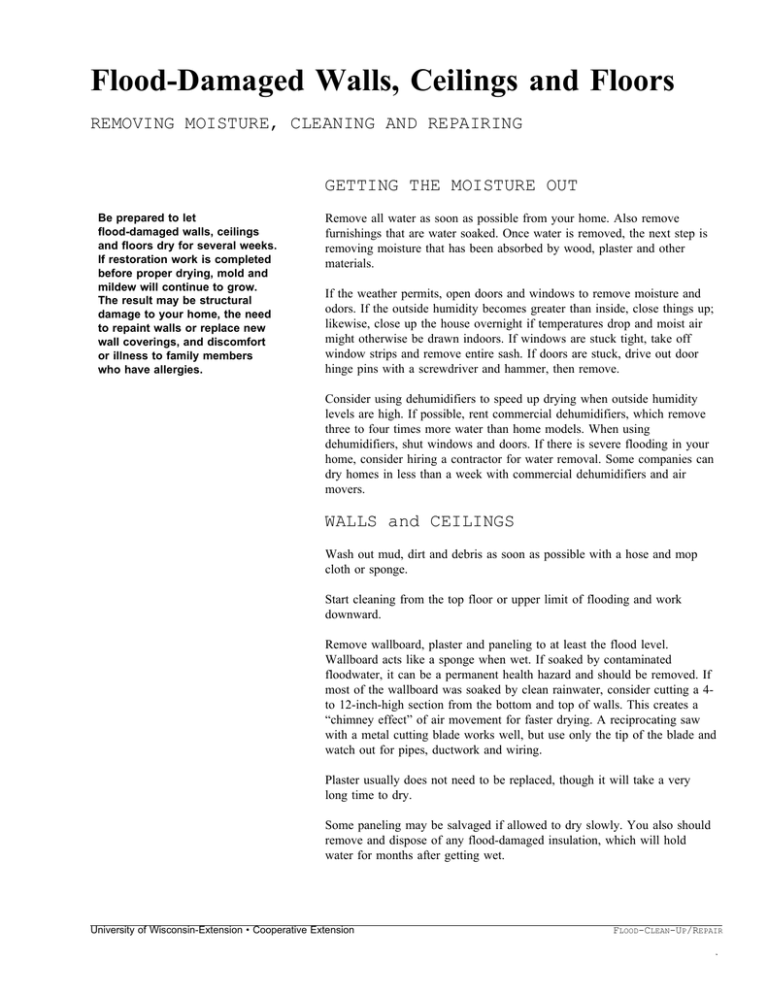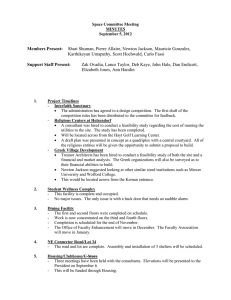Flood-Damaged Walls, Ceilings and Floors
advertisement

Flood-Damaged Walls, Ceilings and Floors REMOVING MOISTURE, CLEANING AND REPAIRING GETTING THE MOISTURE OUT Be prepared to let flood-damaged walls, ceilings and floors dry for several weeks. If restoration work is completed before proper drying, mold and mildew will continue to grow. The result may be structural damage to your home, the need to repaint walls or replace new wall coverings, and discomfort or illness to family members who have allergies. Remove all water as soon as possible from your home. Also remove furnishings that are water soaked. Once water is removed, the next step is removing moisture that has been absorbed by wood, plaster and other materials. If the weather permits, open doors and windows to remove moisture and odors. If the outside humidity becomes greater than inside, close things up; likewise, close up the house overnight if temperatures drop and moist air might otherwise be drawn indoors. If windows are stuck tight, take off window strips and remove entire sash. If doors are stuck, drive out door hinge pins with a screwdriver and hammer, then remove. Consider using dehumidifiers to speed up drying when outside humidity levels are high. If possible, rent commercial dehumidifiers, which remove three to four times more water than home models. When using dehumidifiers, shut windows and doors. If there is severe flooding in your home, consider hiring a contractor for water removal. Some companies can dry homes in less than a week with commercial dehumidifiers and air movers. WALLS and CEILINGS Wash out mud, dirt and debris as soon as possible with a hose and mop cloth or sponge. Start cleaning from the top floor or upper limit of flooding and work downward. Remove wallboard, plaster and paneling to at least the flood level. Wallboard acts like a sponge when wet. If soaked by contaminated floodwater, it can be a permanent health hazard and should be removed. If most of the wallboard was soaked by clean rainwater, consider cutting a 4to 12-inch-high section from the bottom and top of walls. This creates a “chimney effect” of air movement for faster drying. A reciprocating saw with a metal cutting blade works well, but use only the tip of the blade and watch out for pipes, ductwork and wiring. Plaster usually does not need to be replaced, though it will take a very long time to dry. Some paneling may be salvaged if allowed to dry slowly. You also should remove and dispose of any flood-damaged insulation, which will hold water for months after getting wet. University of Wisconsin-Extension • Cooperative Extension FLOOD-CLEAN-UP/REPAIR more information REMOVING MILDEW To clean surfaces: To remove surface mildew on walls or ceilings, use a mildew surface cleaner (available at paint stores) or: scrub the mildew with household detergent, then scrub with a solution of one-quarter cup bleach to 1 quart water. Rinse well with clean water. Once fully dry, apply a coat of paint containing an anti-mildew agent. ♦ Thoroughly wash and disinfect walls, ceilings, exposed wall cavities and studs. ♦ Use a good disinfectant to prevent mildew build-up. One cup of chlorine bleach mixed with a gallon of water works well. For a soapier cleaning solution, add a half cup of mild detergent. Wear rubber gloves. ♦ If walls have already dried, work from the floor to the ceiling to prevent streaking. (Dirty water splashed on dry walls may be absorbed and become almost impossible to remove.) Overlap sections, cleaning the ceiling last. To remove surface mildew on floors and woodwork, use a phosphate cleaning solution such as powdered automatic dishwashing detergent or trisodium phosphate (4 to 6 tablespoons to a gallon of water), available in hardware stores. Rinse with water, and when dry, apply a mildew-resistant finish. FLOORS Before the house has dried out, scrub floors and woodwork with a stiff brush, plenty of water, a detergent and disinfectant. Carpeting soaked by contaminated floodwater should be removed and discarded unless it can be sanitized at a commercial facility for a cost substantially less than replacement. Vinyl flooring and floor tile may need to be removed to allow drying of subfloor. Wooden floors should be dried gradually. Sudden drying could cause cracking or splitting. Some restoration companies can accelerate drying time by forcing air through the fluted underside of hardwood floorboards. ONCE FLOORS HAVE DRIED Additional resources: Your county family living agent, your local emergency government office, the American Red Cross, the Federal Emergency Management Agency Related publications: Assess whether your floors can be repaired, replaced or recovered. Consider your time and budget as you make any decisions. If hardwood floors are damaged beyond repair, you may want to forego the cost of replacement and instead cover them with carpeting, vinyl or linoleum. Or you might lay a new floor over the old, rather than replace it. ♦ Plywood subfloors may have delaminated (separated) from excessive moisture, causing buckling. Sections may have to be replaced or have new plywood nailed over them. Consult a contractor for this work. ♦ If buckling or warping has occurred, drive nails where the floor tends to lift or bulge. This will prevent further damage. Badly warped hardwood floors usually can't be repaired. Warped, wide pine board flooring, however, will often flatten out after it has thoroughly dried. ♦ Plane or sand floors level. Do not refinish until thoroughly dry. “Repairing Your Flooded Home,” American Red Cross/Federal Emergency Management Agency, 1992. UW-Extension Publications– “Removing Water From the Building Materials of a Water Damaged Home;” “High Humidity After Water Damage and the Growth of Mildew and Mites.” Information from: University of Wisconsin Cooperative Extension, Pennsylvania State University Cooperative Extension Service, University of Missouri Extension University of Wisconsin-Extension • Cooperative Extension



